Multinational Companies and Their Impact on Host Economies: China
VerifiedAdded on 2021/02/20
|25
|4762
|256
Report
AI Summary
This report examines the influence of multinational companies (MNCs) on the business environment of host countries, with a specific focus on Unilever's operations in China. The research begins with an introduction to globalization and the role of MNCs, highlighting both the benefits and challenges they present. The report outlines the aims, objectives, and rationale for the study, including the research questions and a project management plan covering scope, cost, time, resources, communication, risk, and quality. A Gantt chart provides a timeline for the project. The methodology section details the research methods, including qualitative approaches, inductive reasoning, and interpretivism. Data collection methods, including primary and secondary sources, are described, as are data analysis techniques and ethical considerations. The report aims to identify the social, economic, and environmental impacts of Unilever on China's business environment, providing recommendations for effective operations. Data collection involves a survey of 35 departmental managers. The research uses a qualitative approach to understand the impact of MNCs.
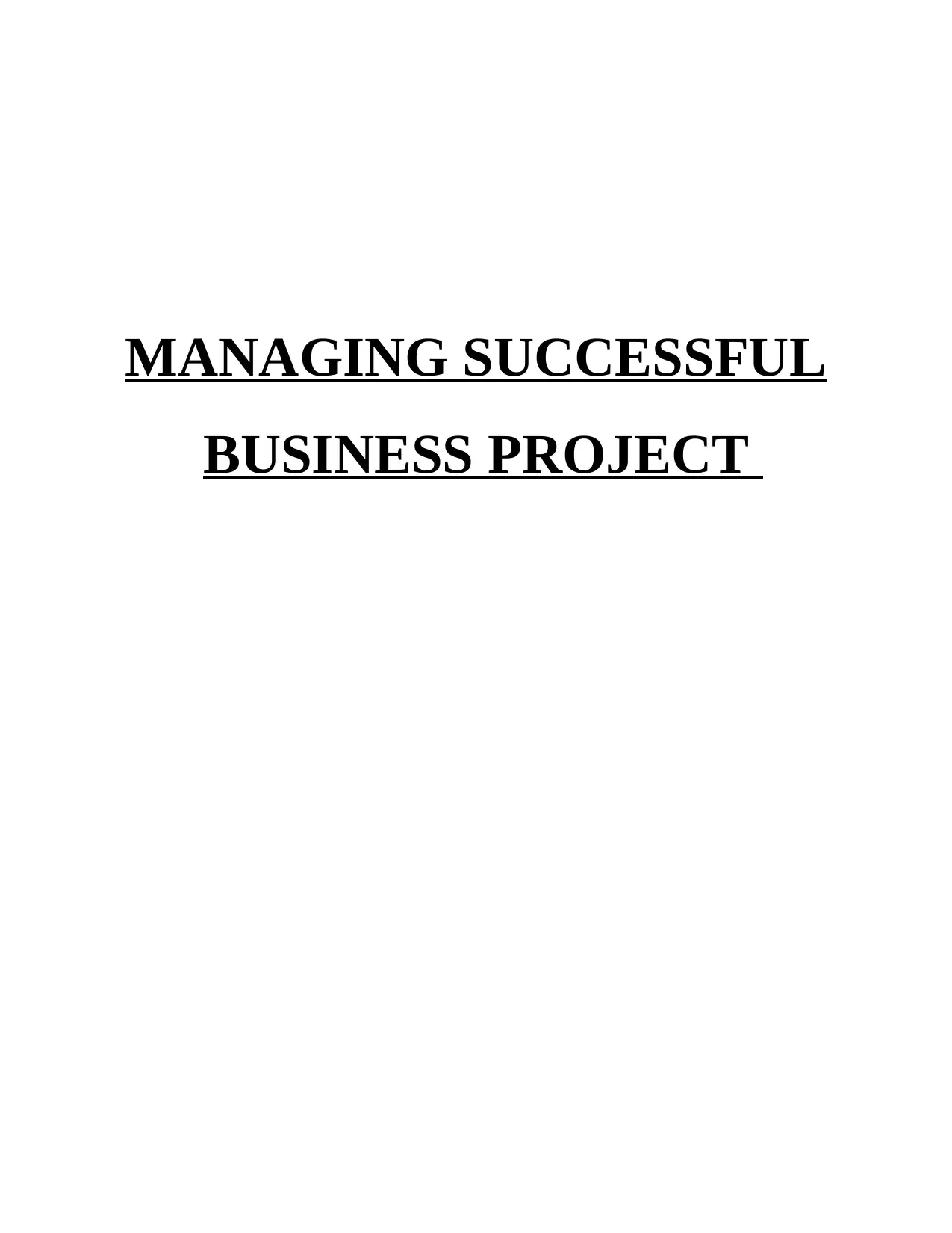
MANAGING SUCCESSFUL
BUSINESS PROJECT
BUSINESS PROJECT
Paraphrase This Document
Need a fresh take? Get an instant paraphrase of this document with our AI Paraphraser
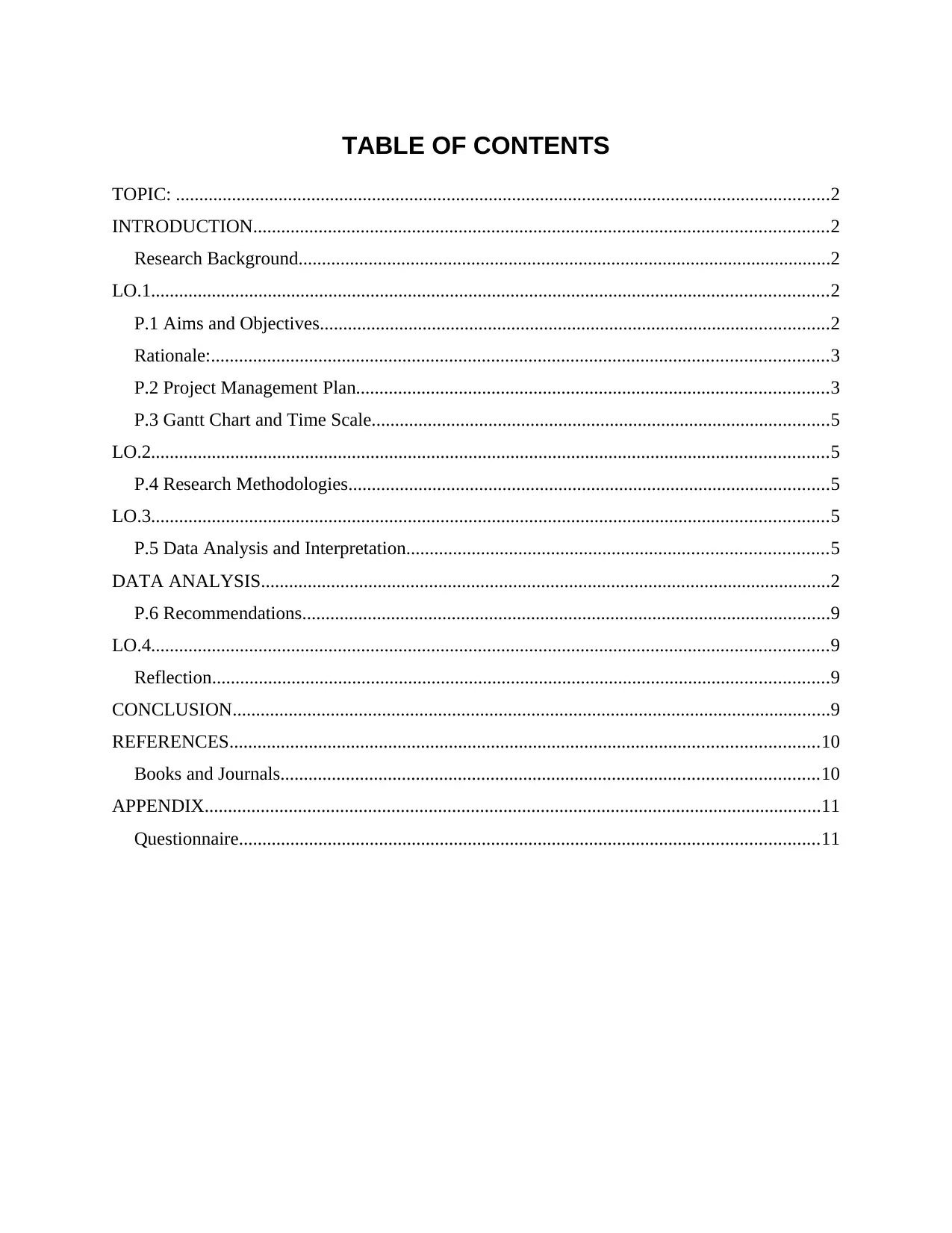
TABLE OF CONTENTS
TOPIC: ............................................................................................................................................2
INTRODUCTION...........................................................................................................................2
Research Background..................................................................................................................2
LO.1.................................................................................................................................................2
P.1 Aims and Objectives.............................................................................................................2
Rationale:....................................................................................................................................3
P.2 Project Management Plan.....................................................................................................3
P.3 Gantt Chart and Time Scale..................................................................................................5
LO.2.................................................................................................................................................5
P.4 Research Methodologies.......................................................................................................5
LO.3.................................................................................................................................................5
P.5 Data Analysis and Interpretation..........................................................................................5
DATA ANALYSIS..........................................................................................................................2
P.6 Recommendations.................................................................................................................9
LO.4.................................................................................................................................................9
Reflection....................................................................................................................................9
CONCLUSION................................................................................................................................9
REFERENCES..............................................................................................................................10
Books and Journals...................................................................................................................10
APPENDIX....................................................................................................................................11
Questionnaire............................................................................................................................11
TOPIC: ............................................................................................................................................2
INTRODUCTION...........................................................................................................................2
Research Background..................................................................................................................2
LO.1.................................................................................................................................................2
P.1 Aims and Objectives.............................................................................................................2
Rationale:....................................................................................................................................3
P.2 Project Management Plan.....................................................................................................3
P.3 Gantt Chart and Time Scale..................................................................................................5
LO.2.................................................................................................................................................5
P.4 Research Methodologies.......................................................................................................5
LO.3.................................................................................................................................................5
P.5 Data Analysis and Interpretation..........................................................................................5
DATA ANALYSIS..........................................................................................................................2
P.6 Recommendations.................................................................................................................9
LO.4.................................................................................................................................................9
Reflection....................................................................................................................................9
CONCLUSION................................................................................................................................9
REFERENCES..............................................................................................................................10
Books and Journals...................................................................................................................10
APPENDIX....................................................................................................................................11
Questionnaire............................................................................................................................11
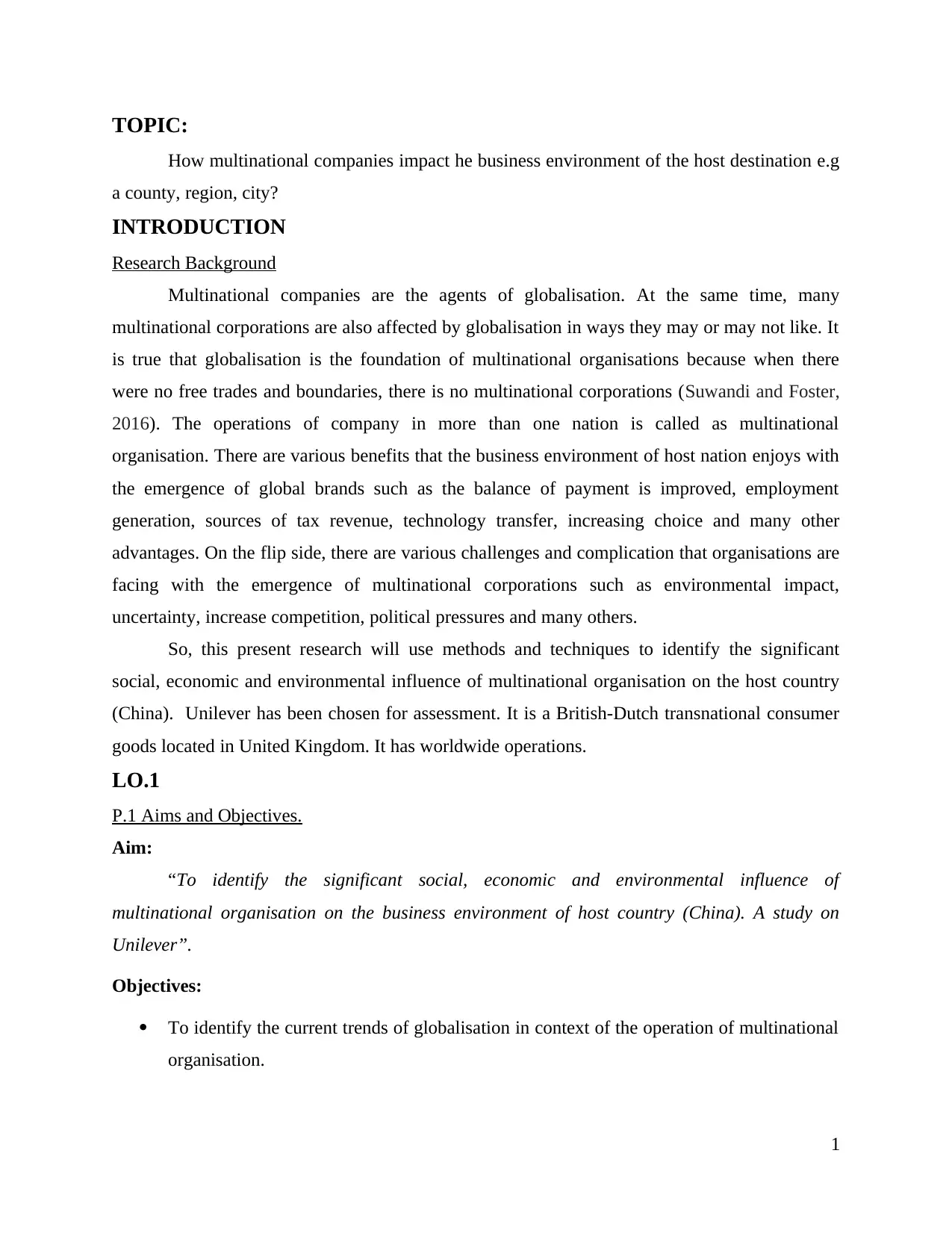
TOPIC:
How multinational companies impact he business environment of the host destination e.g
a county, region, city?
INTRODUCTION
Research Background
Multinational companies are the agents of globalisation. At the same time, many
multinational corporations are also affected by globalisation in ways they may or may not like. It
is true that globalisation is the foundation of multinational organisations because when there
were no free trades and boundaries, there is no multinational corporations (Suwandi and Foster,
2016). The operations of company in more than one nation is called as multinational
organisation. There are various benefits that the business environment of host nation enjoys with
the emergence of global brands such as the balance of payment is improved, employment
generation, sources of tax revenue, technology transfer, increasing choice and many other
advantages. On the flip side, there are various challenges and complication that organisations are
facing with the emergence of multinational corporations such as environmental impact,
uncertainty, increase competition, political pressures and many others.
So, this present research will use methods and techniques to identify the significant
social, economic and environmental influence of multinational organisation on the host country
(China). Unilever has been chosen for assessment. It is a British-Dutch transnational consumer
goods located in United Kingdom. It has worldwide operations.
LO.1
P.1 Aims and Objectives.
Aim:
“To identify the significant social, economic and environmental influence of
multinational organisation on the business environment of host country (China). A study on
Unilever”.
Objectives:
To identify the current trends of globalisation in context of the operation of multinational
organisation.
1
How multinational companies impact he business environment of the host destination e.g
a county, region, city?
INTRODUCTION
Research Background
Multinational companies are the agents of globalisation. At the same time, many
multinational corporations are also affected by globalisation in ways they may or may not like. It
is true that globalisation is the foundation of multinational organisations because when there
were no free trades and boundaries, there is no multinational corporations (Suwandi and Foster,
2016). The operations of company in more than one nation is called as multinational
organisation. There are various benefits that the business environment of host nation enjoys with
the emergence of global brands such as the balance of payment is improved, employment
generation, sources of tax revenue, technology transfer, increasing choice and many other
advantages. On the flip side, there are various challenges and complication that organisations are
facing with the emergence of multinational corporations such as environmental impact,
uncertainty, increase competition, political pressures and many others.
So, this present research will use methods and techniques to identify the significant
social, economic and environmental influence of multinational organisation on the host country
(China). Unilever has been chosen for assessment. It is a British-Dutch transnational consumer
goods located in United Kingdom. It has worldwide operations.
LO.1
P.1 Aims and Objectives.
Aim:
“To identify the significant social, economic and environmental influence of
multinational organisation on the business environment of host country (China). A study on
Unilever”.
Objectives:
To identify the current trends of globalisation in context of the operation of multinational
organisation.
1
⊘ This is a preview!⊘
Do you want full access?
Subscribe today to unlock all pages.

Trusted by 1+ million students worldwide
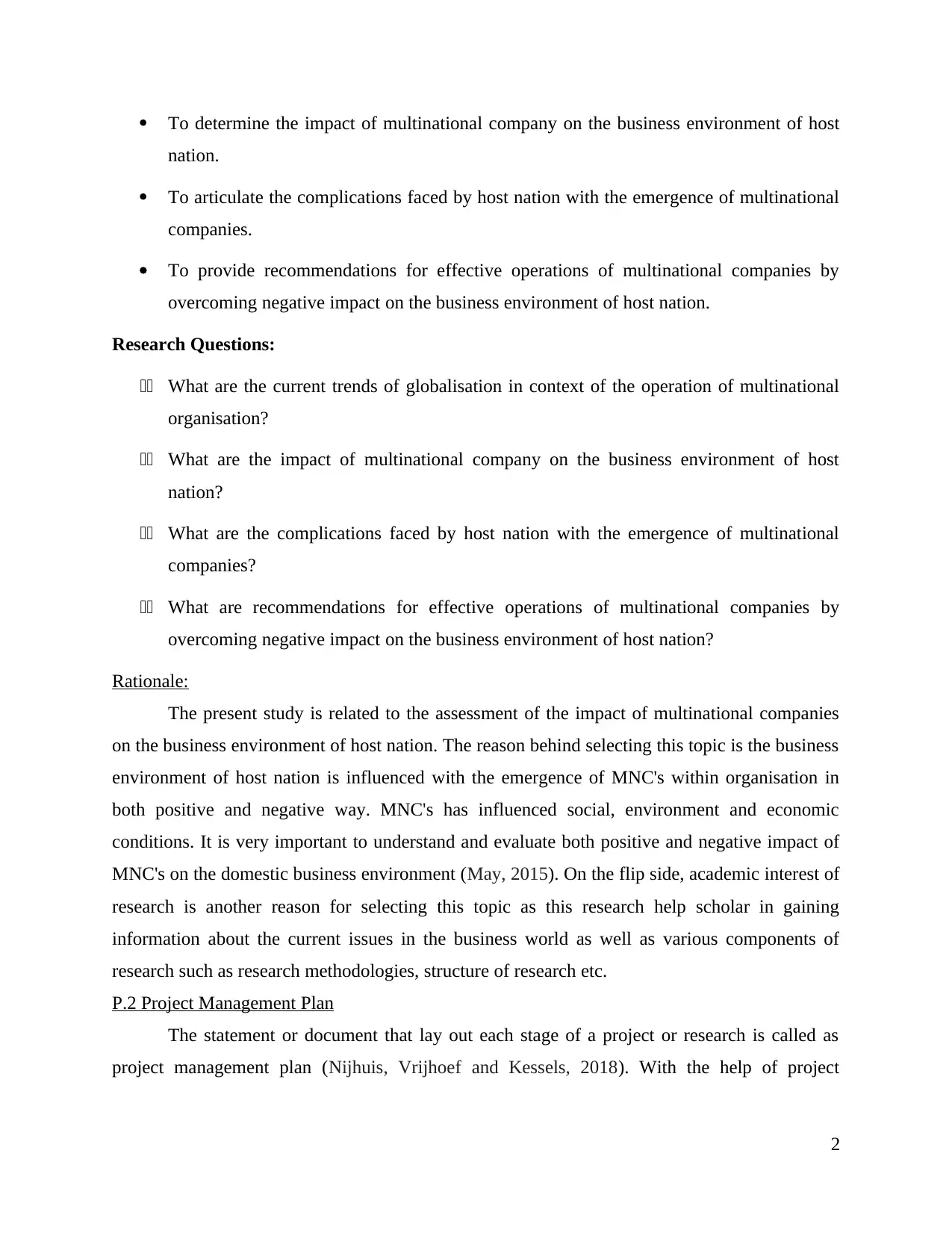
To determine the impact of multinational company on the business environment of host
nation.
To articulate the complications faced by host nation with the emergence of multinational
companies.
To provide recommendations for effective operations of multinational companies by
overcoming negative impact on the business environment of host nation.
Research Questions:
11 What are the current trends of globalisation in context of the operation of multinational
organisation?
11 What are the impact of multinational company on the business environment of host
nation?
11 What are the complications faced by host nation with the emergence of multinational
companies?
11 What are recommendations for effective operations of multinational companies by
overcoming negative impact on the business environment of host nation?
Rationale:
The present study is related to the assessment of the impact of multinational companies
on the business environment of host nation. The reason behind selecting this topic is the business
environment of host nation is influenced with the emergence of MNC's within organisation in
both positive and negative way. MNC's has influenced social, environment and economic
conditions. It is very important to understand and evaluate both positive and negative impact of
MNC's on the domestic business environment (May, 2015). On the flip side, academic interest of
research is another reason for selecting this topic as this research help scholar in gaining
information about the current issues in the business world as well as various components of
research such as research methodologies, structure of research etc.
P.2 Project Management Plan
The statement or document that lay out each stage of a project or research is called as
project management plan (Nijhuis, Vrijhoef and Kessels, 2018). With the help of project
2
nation.
To articulate the complications faced by host nation with the emergence of multinational
companies.
To provide recommendations for effective operations of multinational companies by
overcoming negative impact on the business environment of host nation.
Research Questions:
11 What are the current trends of globalisation in context of the operation of multinational
organisation?
11 What are the impact of multinational company on the business environment of host
nation?
11 What are the complications faced by host nation with the emergence of multinational
companies?
11 What are recommendations for effective operations of multinational companies by
overcoming negative impact on the business environment of host nation?
Rationale:
The present study is related to the assessment of the impact of multinational companies
on the business environment of host nation. The reason behind selecting this topic is the business
environment of host nation is influenced with the emergence of MNC's within organisation in
both positive and negative way. MNC's has influenced social, environment and economic
conditions. It is very important to understand and evaluate both positive and negative impact of
MNC's on the domestic business environment (May, 2015). On the flip side, academic interest of
research is another reason for selecting this topic as this research help scholar in gaining
information about the current issues in the business world as well as various components of
research such as research methodologies, structure of research etc.
P.2 Project Management Plan
The statement or document that lay out each stage of a project or research is called as
project management plan (Nijhuis, Vrijhoef and Kessels, 2018). With the help of project
2
Paraphrase This Document
Need a fresh take? Get an instant paraphrase of this document with our AI Paraphraser
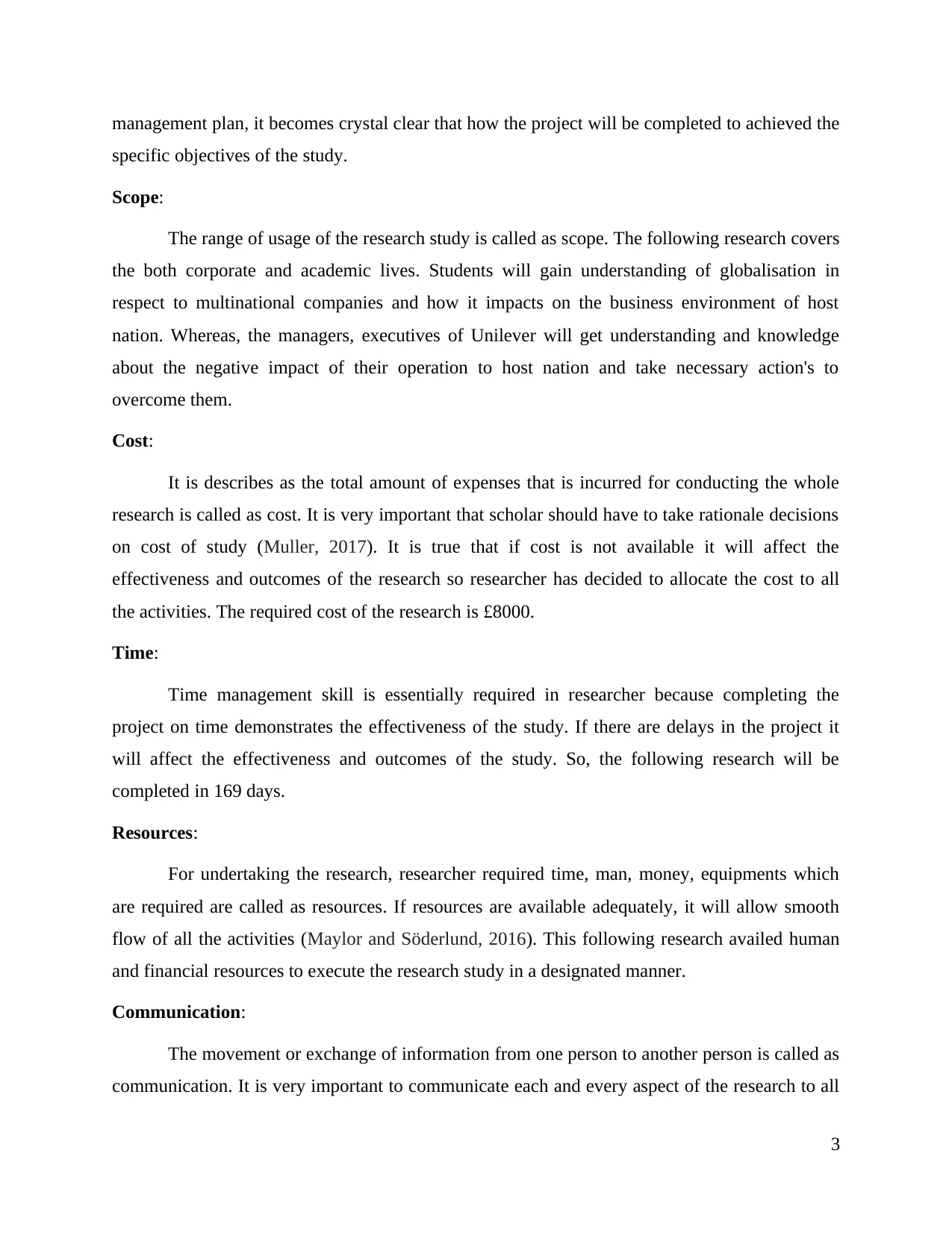
management plan, it becomes crystal clear that how the project will be completed to achieved the
specific objectives of the study.
Scope:
The range of usage of the research study is called as scope. The following research covers
the both corporate and academic lives. Students will gain understanding of globalisation in
respect to multinational companies and how it impacts on the business environment of host
nation. Whereas, the managers, executives of Unilever will get understanding and knowledge
about the negative impact of their operation to host nation and take necessary action's to
overcome them.
Cost:
It is describes as the total amount of expenses that is incurred for conducting the whole
research is called as cost. It is very important that scholar should have to take rationale decisions
on cost of study (Muller, 2017). It is true that if cost is not available it will affect the
effectiveness and outcomes of the research so researcher has decided to allocate the cost to all
the activities. The required cost of the research is £8000.
Time:
Time management skill is essentially required in researcher because completing the
project on time demonstrates the effectiveness of the study. If there are delays in the project it
will affect the effectiveness and outcomes of the study. So, the following research will be
completed in 169 days.
Resources:
For undertaking the research, researcher required time, man, money, equipments which
are required are called as resources. If resources are available adequately, it will allow smooth
flow of all the activities (Maylor and Söderlund, 2016). This following research availed human
and financial resources to execute the research study in a designated manner.
Communication:
The movement or exchange of information from one person to another person is called as
communication. It is very important to communicate each and every aspect of the research to all
3
specific objectives of the study.
Scope:
The range of usage of the research study is called as scope. The following research covers
the both corporate and academic lives. Students will gain understanding of globalisation in
respect to multinational companies and how it impacts on the business environment of host
nation. Whereas, the managers, executives of Unilever will get understanding and knowledge
about the negative impact of their operation to host nation and take necessary action's to
overcome them.
Cost:
It is describes as the total amount of expenses that is incurred for conducting the whole
research is called as cost. It is very important that scholar should have to take rationale decisions
on cost of study (Muller, 2017). It is true that if cost is not available it will affect the
effectiveness and outcomes of the research so researcher has decided to allocate the cost to all
the activities. The required cost of the research is £8000.
Time:
Time management skill is essentially required in researcher because completing the
project on time demonstrates the effectiveness of the study. If there are delays in the project it
will affect the effectiveness and outcomes of the study. So, the following research will be
completed in 169 days.
Resources:
For undertaking the research, researcher required time, man, money, equipments which
are required are called as resources. If resources are available adequately, it will allow smooth
flow of all the activities (Maylor and Söderlund, 2016). This following research availed human
and financial resources to execute the research study in a designated manner.
Communication:
The movement or exchange of information from one person to another person is called as
communication. It is very important to communicate each and every aspect of the research to all
3
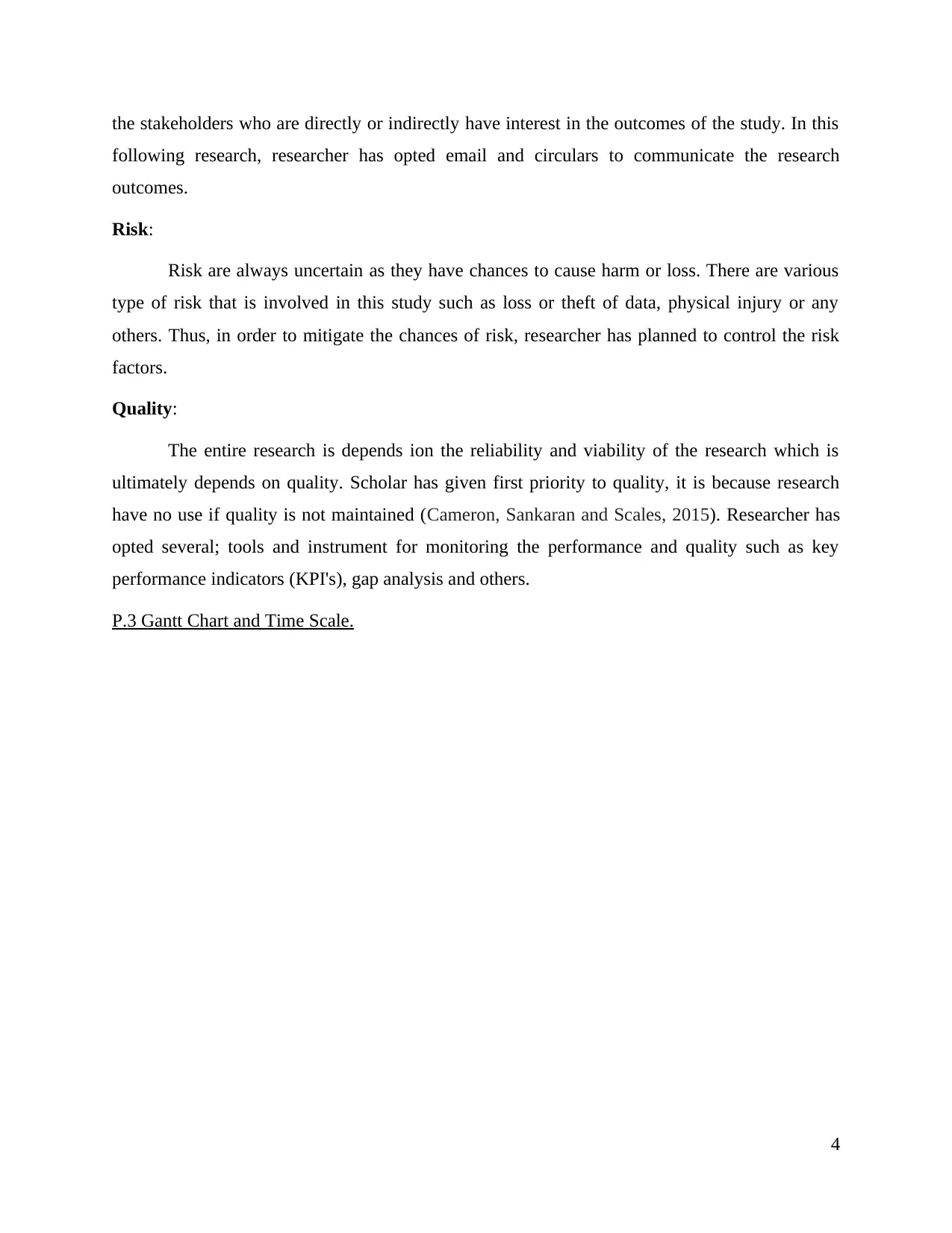
the stakeholders who are directly or indirectly have interest in the outcomes of the study. In this
following research, researcher has opted email and circulars to communicate the research
outcomes.
Risk:
Risk are always uncertain as they have chances to cause harm or loss. There are various
type of risk that is involved in this study such as loss or theft of data, physical injury or any
others. Thus, in order to mitigate the chances of risk, researcher has planned to control the risk
factors.
Quality:
The entire research is depends ion the reliability and viability of the research which is
ultimately depends on quality. Scholar has given first priority to quality, it is because research
have no use if quality is not maintained (Cameron, Sankaran and Scales, 2015). Researcher has
opted several; tools and instrument for monitoring the performance and quality such as key
performance indicators (KPI's), gap analysis and others.
P.3 Gantt Chart and Time Scale.
4
following research, researcher has opted email and circulars to communicate the research
outcomes.
Risk:
Risk are always uncertain as they have chances to cause harm or loss. There are various
type of risk that is involved in this study such as loss or theft of data, physical injury or any
others. Thus, in order to mitigate the chances of risk, researcher has planned to control the risk
factors.
Quality:
The entire research is depends ion the reliability and viability of the research which is
ultimately depends on quality. Scholar has given first priority to quality, it is because research
have no use if quality is not maintained (Cameron, Sankaran and Scales, 2015). Researcher has
opted several; tools and instrument for monitoring the performance and quality such as key
performance indicators (KPI's), gap analysis and others.
P.3 Gantt Chart and Time Scale.
4
⊘ This is a preview!⊘
Do you want full access?
Subscribe today to unlock all pages.

Trusted by 1+ million students worldwide
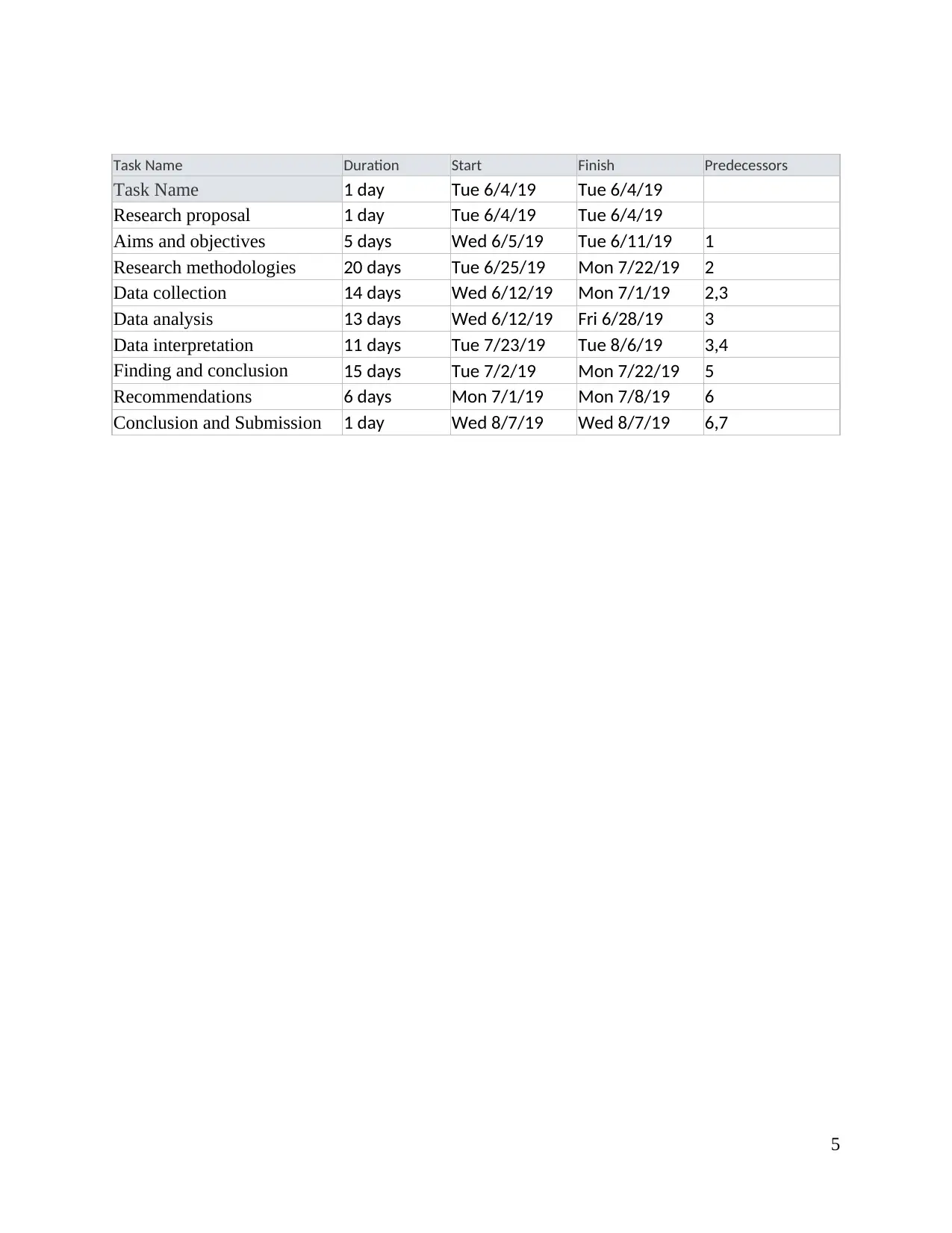
Task Name Duration Start Finish Predecessors
Task Name 1 day Tue 6/4/19 Tue 6/4/19
Research proposal 1 day Tue 6/4/19 Tue 6/4/19
Aims and objectives 5 days Wed 6/5/19 Tue 6/11/19 1
Research methodologies 20 days Tue 6/25/19 Mon 7/22/19 2
Data collection 14 days Wed 6/12/19 Mon 7/1/19 2,3
Data analysis 13 days Wed 6/12/19 Fri 6/28/19 3
Data interpretation 11 days Tue 7/23/19 Tue 8/6/19 3,4
Finding and conclusion 15 days Tue 7/2/19 Mon 7/22/19 5
Recommendations 6 days Mon 7/1/19 Mon 7/8/19 6
Conclusion and Submission 1 day Wed 8/7/19 Wed 8/7/19 6,7
5
Task Name 1 day Tue 6/4/19 Tue 6/4/19
Research proposal 1 day Tue 6/4/19 Tue 6/4/19
Aims and objectives 5 days Wed 6/5/19 Tue 6/11/19 1
Research methodologies 20 days Tue 6/25/19 Mon 7/22/19 2
Data collection 14 days Wed 6/12/19 Mon 7/1/19 2,3
Data analysis 13 days Wed 6/12/19 Fri 6/28/19 3
Data interpretation 11 days Tue 7/23/19 Tue 8/6/19 3,4
Finding and conclusion 15 days Tue 7/2/19 Mon 7/22/19 5
Recommendations 6 days Mon 7/1/19 Mon 7/8/19 6
Conclusion and Submission 1 day Wed 8/7/19 Wed 8/7/19 6,7
5
Paraphrase This Document
Need a fresh take? Get an instant paraphrase of this document with our AI Paraphraser
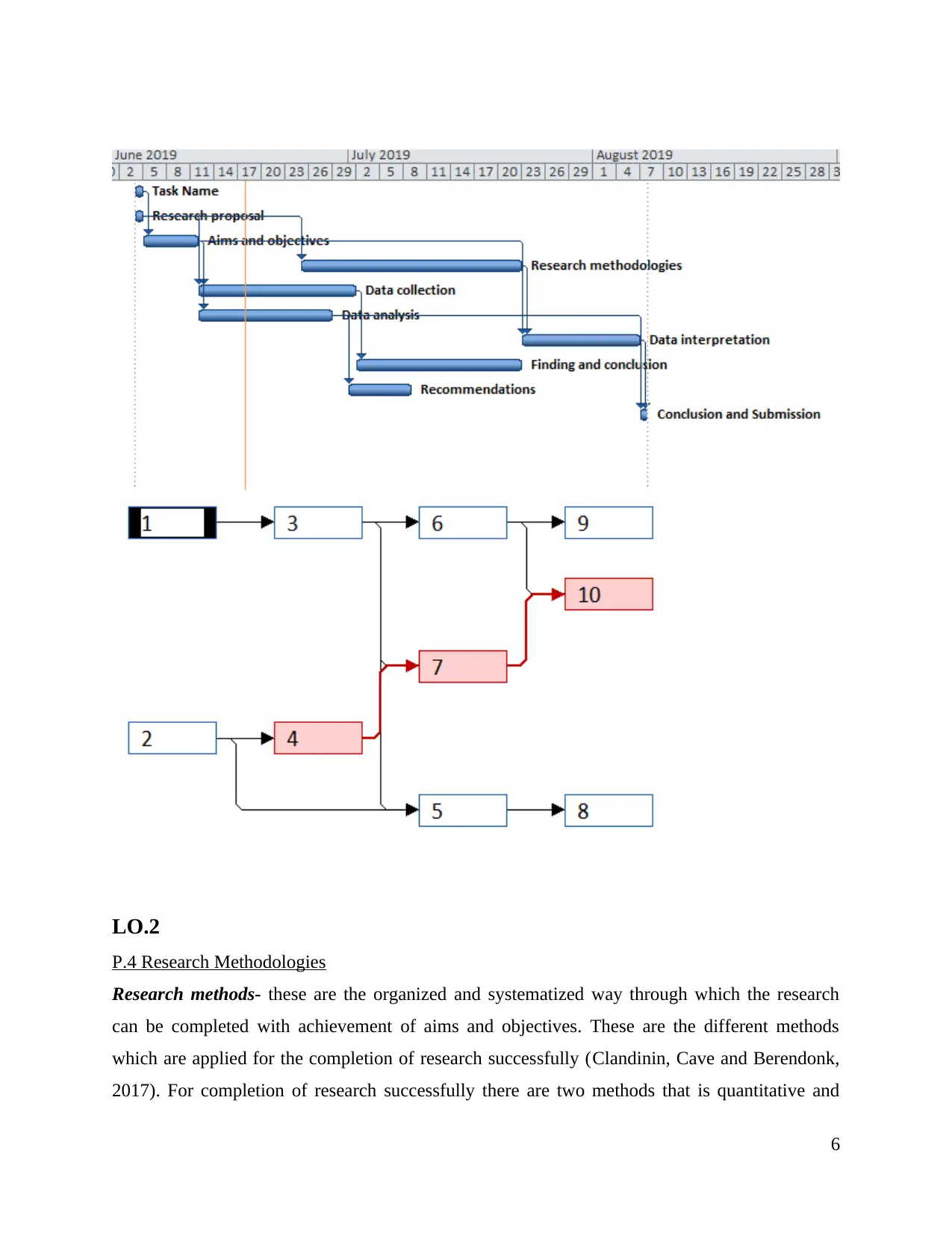
LO.2
P.4 Research Methodologies
Research methods- these are the organized and systematized way through which the research
can be completed with achievement of aims and objectives. These are the different methods
which are applied for the completion of research successfully (Clandinin, Cave and Berendonk,
2017). For completion of research successfully there are two methods that is quantitative and
6
P.4 Research Methodologies
Research methods- these are the organized and systematized way through which the research
can be completed with achievement of aims and objectives. These are the different methods
which are applied for the completion of research successfully (Clandinin, Cave and Berendonk,
2017). For completion of research successfully there are two methods that is quantitative and
6
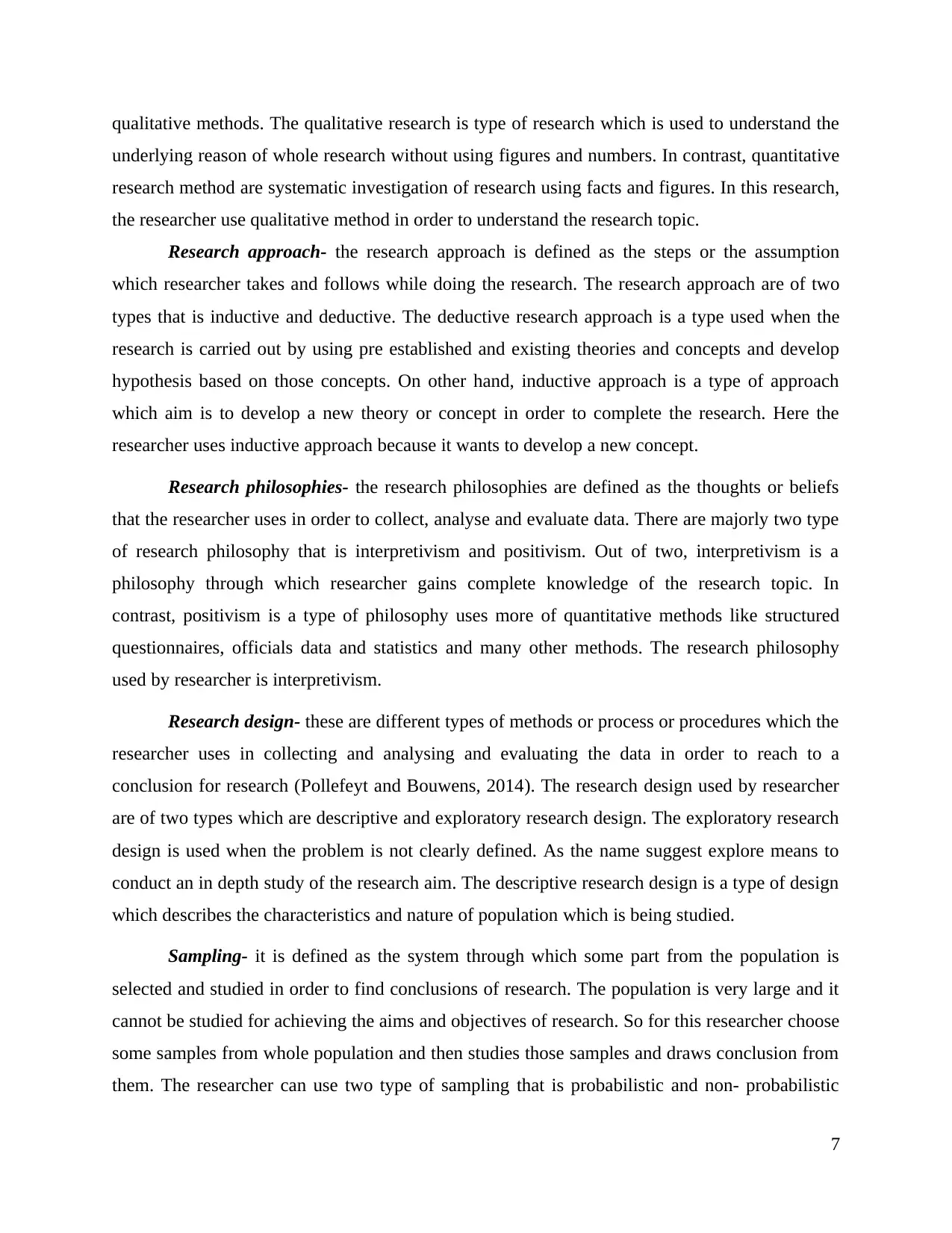
qualitative methods. The qualitative research is type of research which is used to understand the
underlying reason of whole research without using figures and numbers. In contrast, quantitative
research method are systematic investigation of research using facts and figures. In this research,
the researcher use qualitative method in order to understand the research topic.
Research approach- the research approach is defined as the steps or the assumption
which researcher takes and follows while doing the research. The research approach are of two
types that is inductive and deductive. The deductive research approach is a type used when the
research is carried out by using pre established and existing theories and concepts and develop
hypothesis based on those concepts. On other hand, inductive approach is a type of approach
which aim is to develop a new theory or concept in order to complete the research. Here the
researcher uses inductive approach because it wants to develop a new concept.
Research philosophies- the research philosophies are defined as the thoughts or beliefs
that the researcher uses in order to collect, analyse and evaluate data. There are majorly two type
of research philosophy that is interpretivism and positivism. Out of two, interpretivism is a
philosophy through which researcher gains complete knowledge of the research topic. In
contrast, positivism is a type of philosophy uses more of quantitative methods like structured
questionnaires, officials data and statistics and many other methods. The research philosophy
used by researcher is interpretivism.
Research design- these are different types of methods or process or procedures which the
researcher uses in collecting and analysing and evaluating the data in order to reach to a
conclusion for research (Pollefeyt and Bouwens, 2014). The research design used by researcher
are of two types which are descriptive and exploratory research design. The exploratory research
design is used when the problem is not clearly defined. As the name suggest explore means to
conduct an in depth study of the research aim. The descriptive research design is a type of design
which describes the characteristics and nature of population which is being studied.
Sampling- it is defined as the system through which some part from the population is
selected and studied in order to find conclusions of research. The population is very large and it
cannot be studied for achieving the aims and objectives of research. So for this researcher choose
some samples from whole population and then studies those samples and draws conclusion from
them. The researcher can use two type of sampling that is probabilistic and non- probabilistic
7
underlying reason of whole research without using figures and numbers. In contrast, quantitative
research method are systematic investigation of research using facts and figures. In this research,
the researcher use qualitative method in order to understand the research topic.
Research approach- the research approach is defined as the steps or the assumption
which researcher takes and follows while doing the research. The research approach are of two
types that is inductive and deductive. The deductive research approach is a type used when the
research is carried out by using pre established and existing theories and concepts and develop
hypothesis based on those concepts. On other hand, inductive approach is a type of approach
which aim is to develop a new theory or concept in order to complete the research. Here the
researcher uses inductive approach because it wants to develop a new concept.
Research philosophies- the research philosophies are defined as the thoughts or beliefs
that the researcher uses in order to collect, analyse and evaluate data. There are majorly two type
of research philosophy that is interpretivism and positivism. Out of two, interpretivism is a
philosophy through which researcher gains complete knowledge of the research topic. In
contrast, positivism is a type of philosophy uses more of quantitative methods like structured
questionnaires, officials data and statistics and many other methods. The research philosophy
used by researcher is interpretivism.
Research design- these are different types of methods or process or procedures which the
researcher uses in collecting and analysing and evaluating the data in order to reach to a
conclusion for research (Pollefeyt and Bouwens, 2014). The research design used by researcher
are of two types which are descriptive and exploratory research design. The exploratory research
design is used when the problem is not clearly defined. As the name suggest explore means to
conduct an in depth study of the research aim. The descriptive research design is a type of design
which describes the characteristics and nature of population which is being studied.
Sampling- it is defined as the system through which some part from the population is
selected and studied in order to find conclusions of research. The population is very large and it
cannot be studied for achieving the aims and objectives of research. So for this researcher choose
some samples from whole population and then studies those samples and draws conclusion from
them. The researcher can use two type of sampling that is probabilistic and non- probabilistic
7
⊘ This is a preview!⊘
Do you want full access?
Subscribe today to unlock all pages.

Trusted by 1+ million students worldwide
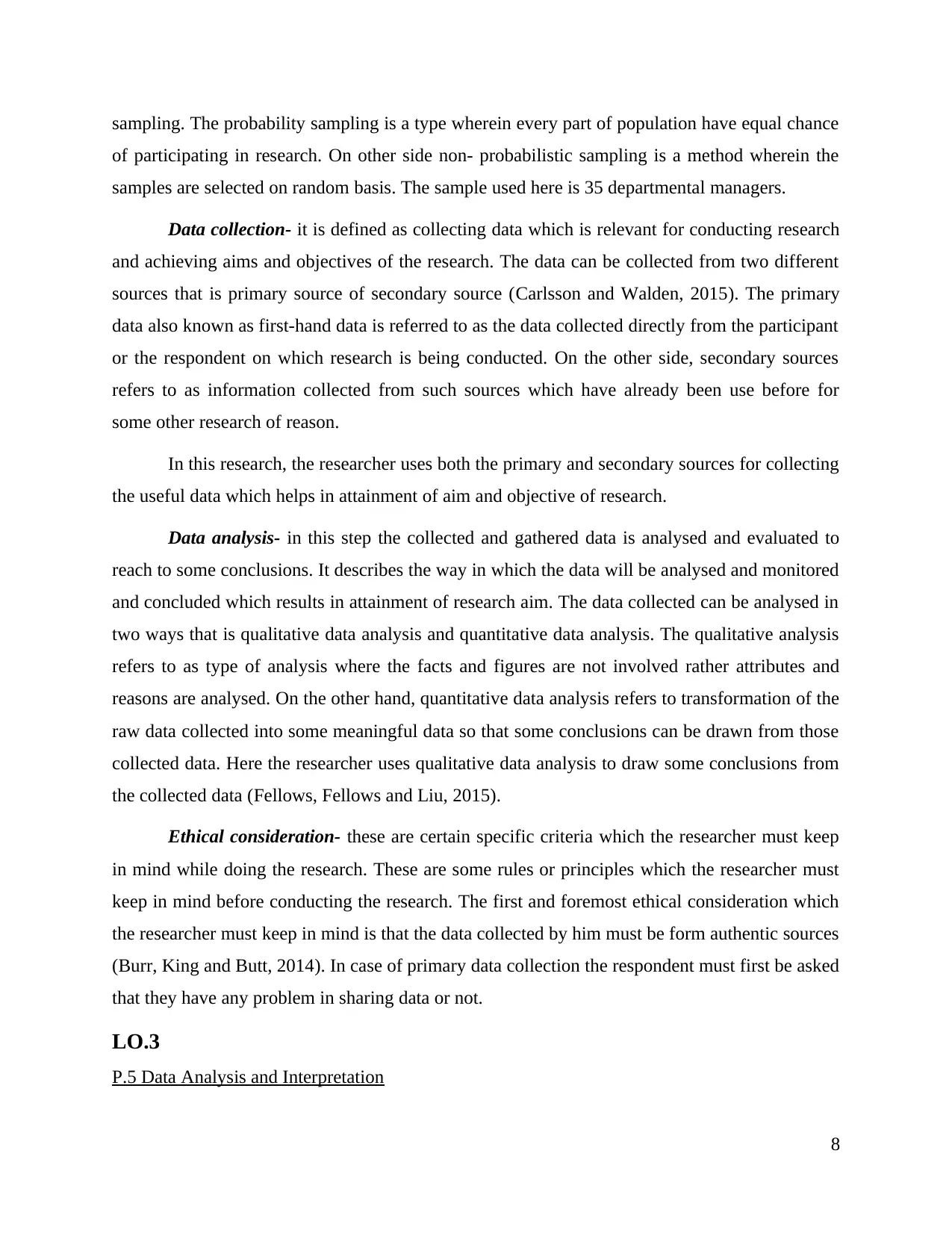
sampling. The probability sampling is a type wherein every part of population have equal chance
of participating in research. On other side non- probabilistic sampling is a method wherein the
samples are selected on random basis. The sample used here is 35 departmental managers.
Data collection- it is defined as collecting data which is relevant for conducting research
and achieving aims and objectives of the research. The data can be collected from two different
sources that is primary source of secondary source (Carlsson and Walden, 2015). The primary
data also known as first-hand data is referred to as the data collected directly from the participant
or the respondent on which research is being conducted. On the other side, secondary sources
refers to as information collected from such sources which have already been use before for
some other research of reason.
In this research, the researcher uses both the primary and secondary sources for collecting
the useful data which helps in attainment of aim and objective of research.
Data analysis- in this step the collected and gathered data is analysed and evaluated to
reach to some conclusions. It describes the way in which the data will be analysed and monitored
and concluded which results in attainment of research aim. The data collected can be analysed in
two ways that is qualitative data analysis and quantitative data analysis. The qualitative analysis
refers to as type of analysis where the facts and figures are not involved rather attributes and
reasons are analysed. On the other hand, quantitative data analysis refers to transformation of the
raw data collected into some meaningful data so that some conclusions can be drawn from those
collected data. Here the researcher uses qualitative data analysis to draw some conclusions from
the collected data (Fellows, Fellows and Liu, 2015).
Ethical consideration- these are certain specific criteria which the researcher must keep
in mind while doing the research. These are some rules or principles which the researcher must
keep in mind before conducting the research. The first and foremost ethical consideration which
the researcher must keep in mind is that the data collected by him must be form authentic sources
(Burr, King and Butt, 2014). In case of primary data collection the respondent must first be asked
that they have any problem in sharing data or not.
LO.3
P.5 Data Analysis and Interpretation
8
of participating in research. On other side non- probabilistic sampling is a method wherein the
samples are selected on random basis. The sample used here is 35 departmental managers.
Data collection- it is defined as collecting data which is relevant for conducting research
and achieving aims and objectives of the research. The data can be collected from two different
sources that is primary source of secondary source (Carlsson and Walden, 2015). The primary
data also known as first-hand data is referred to as the data collected directly from the participant
or the respondent on which research is being conducted. On the other side, secondary sources
refers to as information collected from such sources which have already been use before for
some other research of reason.
In this research, the researcher uses both the primary and secondary sources for collecting
the useful data which helps in attainment of aim and objective of research.
Data analysis- in this step the collected and gathered data is analysed and evaluated to
reach to some conclusions. It describes the way in which the data will be analysed and monitored
and concluded which results in attainment of research aim. The data collected can be analysed in
two ways that is qualitative data analysis and quantitative data analysis. The qualitative analysis
refers to as type of analysis where the facts and figures are not involved rather attributes and
reasons are analysed. On the other hand, quantitative data analysis refers to transformation of the
raw data collected into some meaningful data so that some conclusions can be drawn from those
collected data. Here the researcher uses qualitative data analysis to draw some conclusions from
the collected data (Fellows, Fellows and Liu, 2015).
Ethical consideration- these are certain specific criteria which the researcher must keep
in mind while doing the research. These are some rules or principles which the researcher must
keep in mind before conducting the research. The first and foremost ethical consideration which
the researcher must keep in mind is that the data collected by him must be form authentic sources
(Burr, King and Butt, 2014). In case of primary data collection the respondent must first be asked
that they have any problem in sharing data or not.
LO.3
P.5 Data Analysis and Interpretation
8
Paraphrase This Document
Need a fresh take? Get an instant paraphrase of this document with our AI Paraphraser

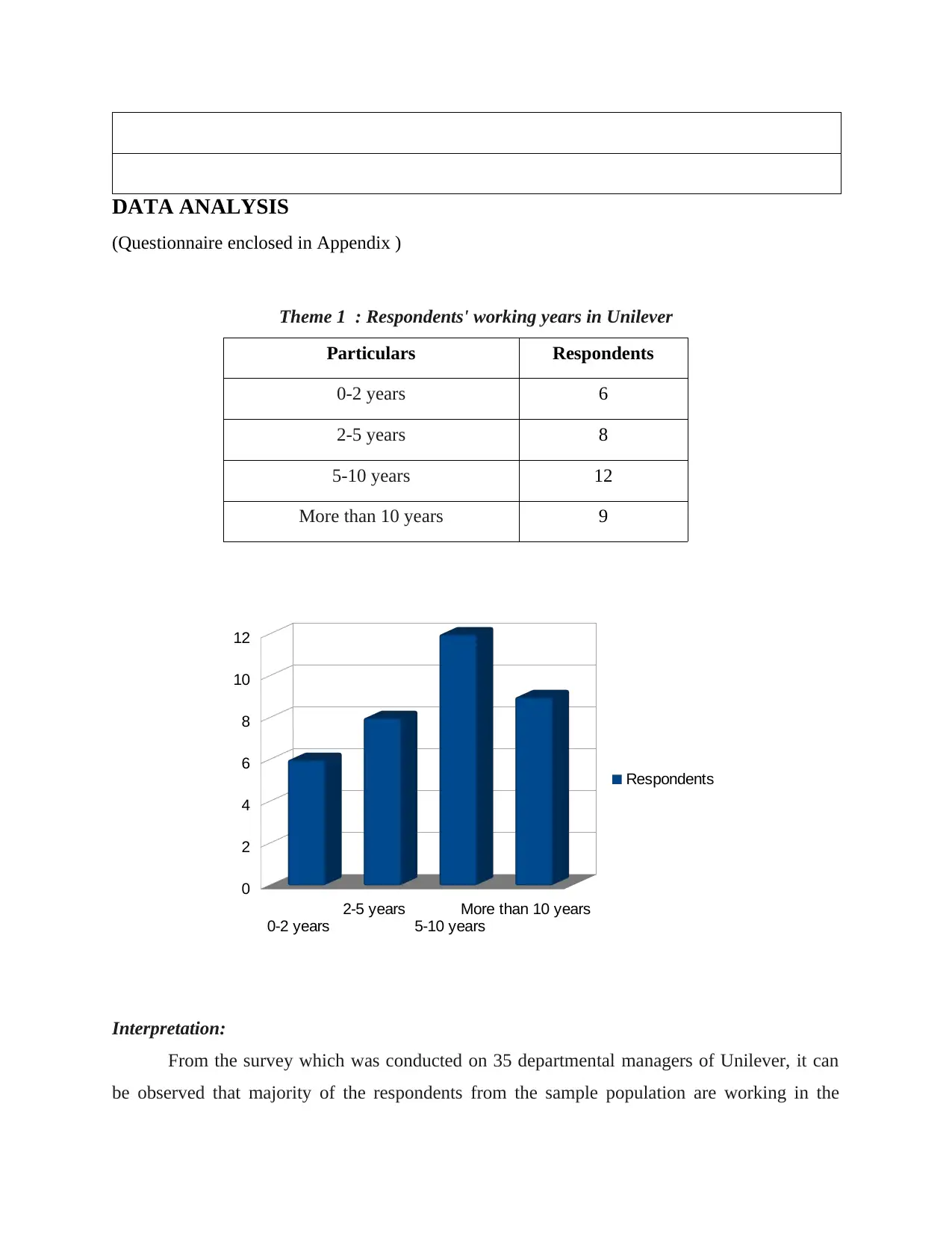
DATA ANALYSIS
(Questionnaire enclosed in Appendix )
Theme 1 : Respondents' working years in Unilever
Particulars Respondents
0-2 years 6
2-5 years 8
5-10 years 12
More than 10 years 9
Interpretation:
From the survey which was conducted on 35 departmental managers of Unilever, it can
be observed that majority of the respondents from the sample population are working in the
0-2 years
2-5 years
5-10 years
More than 10 years
0
2
4
6
8
10
12
Respondents
(Questionnaire enclosed in Appendix )
Theme 1 : Respondents' working years in Unilever
Particulars Respondents
0-2 years 6
2-5 years 8
5-10 years 12
More than 10 years 9
Interpretation:
From the survey which was conducted on 35 departmental managers of Unilever, it can
be observed that majority of the respondents from the sample population are working in the
0-2 years
2-5 years
5-10 years
More than 10 years
0
2
4
6
8
10
12
Respondents
⊘ This is a preview!⊘
Do you want full access?
Subscribe today to unlock all pages.

Trusted by 1+ million students worldwide
1 out of 25
Related Documents
Your All-in-One AI-Powered Toolkit for Academic Success.
+13062052269
info@desklib.com
Available 24*7 on WhatsApp / Email
![[object Object]](/_next/static/media/star-bottom.7253800d.svg)
Unlock your academic potential
Copyright © 2020–2025 A2Z Services. All Rights Reserved. Developed and managed by ZUCOL.





